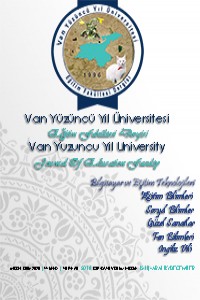Fazıl Hüsnü Dağlarca’nın Yapma Destanlarındaki Rol-Modelin İlköğretim II. Kademe Öğrencileri İçin Eğitsel Açıdan İncelenmesi
Abstract
Bu araştırma Fazıl Hüsnü
Dağlarca'nın yapma destanlarındaki kahramanların ilköğretim II. kademe
öğrencileri tarafından model alınıp alınmayacağının, model alınacaksa hangi
ölçülerde ve hangi yönlerden model alınacağının tespiti amacıyla
yapılmıştır. Araştırmanın çalışma sahasını oluşturan Muş ilinin Bulanık
ilçesinde 2010-2011 eğitim- öğretim yılında 8. sınıf öğrencilerine Fazıl Hüsnü
Dağlarca’nın destanlarındaki kahramanları örnek alıp almayacaklarıyla ilgili 50
sorudan oluşan ön test ve son test şeklinde bir değerlendirme formu uygulanmıştır.
Araştırmada kullanılan değerlendirme formu 4 bölümden oluşmaktadır. I. Bölümde
kahramanın kişilik bakımından güçlü yönleri elde edilmeye çalışılmıştır. II.
Bölümde kahramanın akademik ve zihinsel bakımdan güçlü yönleri tespit edilmeye çalışılmıştır.
III. Bölümde kahramanın sosyal bakımdan güçlü yönleri tespit edilmeye
çalışılmıştır. IV. Bölümde kahramanın eğitsel açıdan güçlü yönleri tespit
edilmeye çalışılmıştır. Araştırmada kullanılan anketin önce ön testi
dağıtılmış, ardından kahramanlarla ilgili yapma destanlar derste işlenmiştir.
Ders bitiminden sonra son test dağıtılmıştır. Değerlendirme sonuçları
bilgisayarda SPSS istatistik
programı ve Excel programı yardımıyla çözümlenmiştir. Araştırma sonucunda,
ilköğretim II. kademe öğrencilerinin Fazıl Hüsnü Dağlarca’nın yapma
destanlarındaki kahramanların model alınıp
alınmadığı; model alınacaksa hangi yönlerden model alındığıyla ilgili çeşitli
tespitlerde bulunulmuştur.
References
- Arı, R. (2005). Gelişim ve öğrenme. Ankara: Nobel.
- Büyüköztürk, Ş., Çakmak, E. K., Akgün, Ö. E., Karadeniz, Ş., & Demirel, F., (2008). Bilimsel araştırma yöntemleri. Ankara: Pegem Akademi. Ceran, D. (2015). Çocuklara rol model olması bakımından millî mücadele kahramanları ve edebî eserlere yansıması: “kurtuluşun kahramanları” kitap dizisi örneği, Tarih Okulu Dergisi, 8(14), 135-157.
- Dinçel, E. (2006). Ergenlik dönemi gelişimsel ödevleri ve psikolojik problemler. (Yayımlanmamış Yüksek Lisans Tezi, Ankara Üniversitesi/Sosyal Bilimler Enstitüsü, Ankara).
- Durmuş, A. (2005). Ergenlik dönemi, İstanbul: Nesil Yayınları.
- Orhan, S.; Bulut, M.; Gedik, M. (2012). Türkçe eğitimi açısından kültürel değerlerin aktarılmasında halk hikâyelerinin yeri ve önemi, International Journal of Social Science, 5(3), 51-57.
- Özcan, H. (2008). Halk edebiyatı metinlerinin çocuk edebiyatına kaynak olması ve örneklem olarak Dede Korkut Hikâyeleri, Turkish Studies, 3 (2), 582- 603.
- Senemoğlu, N. (2010). Gelişim, öğrenme ve öğretim, Ankara: Pegem Akademi.
- Topses, G. (2003). Gelişim ve öğrenme psikolojisi. Ankara: Nobel Yayın Dağıtım.
An Examination of The Role-Model in Fazil Hüsnü Dağlarca’s Artifical Epics for Secondary Stope Students in Educational Terms
Abstract
The aim of this study is to
determine whether the characters in Fazıl Hüsnü Dağlarca’s artificial epic is
taken as role models by students in the secondary stage of primary schools; and
if so, to what extent and in which aspects they are taken as role models. A evaluation form which is composed of 50 questions and which is about
whether eighth grade students in
primary schools take characters in Fazıl Hüsnü Dağlarca’s epic as role models
has been applied as pre-tests and post-tests in Bulanık Province of Muş city,
which constitues the area of the study, in 2010-2011 education year. The evaluation form used in the study
is composed of 4 parts. In the first part, it is aimed to gather the strengths
of the character in terms of personality. In the second part, it is aimed to
determine the academic and cognitive strengths of the character. In the third
part, it is aimed to determine the social strengths of the charater. In the
fourth part, it is aimed to determine the pedagogical strengths of the
character. Initially, the pre-tests of the survey used in the study have been
distributed, and afterwards the artificial epics about the characters have been
covered in the lesson. After the end of the lesson, the post-tests have been
distributed. The results of the evaluation form have been analysed with the help of SPSS statistics
programme and Excel programme. In the result of the study, various
determinations about whether the characters in Fazıl Hüsnü Dağlarca’s
artificial epic is taken as role models by students in the
secondary stage of primary schools; and if so, to what extent and in which
aspects the characters are taken as role models have been made.
References
- Arı, R. (2005). Gelişim ve öğrenme. Ankara: Nobel.
- Büyüköztürk, Ş., Çakmak, E. K., Akgün, Ö. E., Karadeniz, Ş., & Demirel, F., (2008). Bilimsel araştırma yöntemleri. Ankara: Pegem Akademi. Ceran, D. (2015). Çocuklara rol model olması bakımından millî mücadele kahramanları ve edebî eserlere yansıması: “kurtuluşun kahramanları” kitap dizisi örneği, Tarih Okulu Dergisi, 8(14), 135-157.
- Dinçel, E. (2006). Ergenlik dönemi gelişimsel ödevleri ve psikolojik problemler. (Yayımlanmamış Yüksek Lisans Tezi, Ankara Üniversitesi/Sosyal Bilimler Enstitüsü, Ankara).
- Durmuş, A. (2005). Ergenlik dönemi, İstanbul: Nesil Yayınları.
- Orhan, S.; Bulut, M.; Gedik, M. (2012). Türkçe eğitimi açısından kültürel değerlerin aktarılmasında halk hikâyelerinin yeri ve önemi, International Journal of Social Science, 5(3), 51-57.
- Özcan, H. (2008). Halk edebiyatı metinlerinin çocuk edebiyatına kaynak olması ve örneklem olarak Dede Korkut Hikâyeleri, Turkish Studies, 3 (2), 582- 603.
- Senemoğlu, N. (2010). Gelişim, öğrenme ve öğretim, Ankara: Pegem Akademi.
- Topses, G. (2003). Gelişim ve öğrenme psikolojisi. Ankara: Nobel Yayın Dağıtım.
Details
| Primary Language | Turkish |
|---|---|
| Journal Section | Articles |
| Authors | |
| Publication Date | November 29, 2018 |
| Published in Issue | Year 2018 Volume: 15 Issue: 1 |


